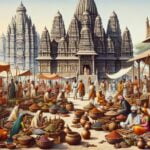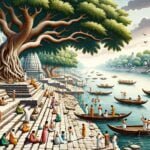Unraveling the Ancient Civilizations of India takes us on a captivating journey to explore the mystifying question of how many civilizations once thrived in ancient India. With the expertise of a seasoned historian specializing in ancient civilizations and a deep understanding of anthropology and archaeology, this article dives into the intricate tapestry of ancient India’s rich past. By delving into deciphering ancient texts, artifacts, and cultural patterns, we uncover the hidden secrets of the formations and developments that shaped this extraordinary region. Prepare to embark on an enlightening exploration of the multifaceted dynamics that birthed and nurtured the civilizations within ancient India’s enthralling realms.
How many civilizations were in ancient India?
India’s ancient history is a tapestry woven with various civilizations that flourished throughout different time periods. As a seasoned historian specializing in ancient civilizations, I delve into the depths of research and academic expertise to unravel their secrets. Today, join me as we explore the intriguing question: How many civilizations were in ancient India?
The Vedic Civilization: An Era of Knowledge and Rituals
One of the distinctive civilizations in ancient India was the Vedic civilization, which thrived from approximately 1500 BCE to 600 BCE. This ancient society derived its name from the sacred texts known as the Vedas. The Vedic civilization is believed to have emerged in the early 3rd millennium BCE, making it one of the oldest civilizations in the Indian subcontinent.
But what characterizes the Vedic civilization?
The Vedic civilization was associated with Aryan tribes, who migrated into the Indian subcontinent from the northwest. These tribes brought with them their rich cultural and religious heritage, which forms the foundation of modern-day Hinduism. The Vedas, composed during this period, contain a wealth of knowledge on various subjects, including rituals, hymns, and philosophical discussions.
As we gaze into the annals of history, we uncover a world where the Vedic civilization thrived with its complex rituals, intricate social structures, and pursuit of knowledge. However, it is important to note that the Vedic civilization was distinct from the later Indian Iron Age kingdoms that emerged in ancient India.
The Indian Iron Age Kingdoms: Iron, Alphabets, and Everlasting Legacies
As the Vedic civilization waned, a new chapter in ancient India’s history began: the Indian Iron Age kingdoms. These kingdoms emerged around 600 BCE and lasted up until 345 BCE. Unlike the Vedic civilization, these kingdoms were characterized by an advanced metallurgical technique—the use of iron—thus cementing their place in history.
What sets the Indian Iron Age kingdoms apart from the Vedic civilization?
While the Vedic civilization focused on religious texts and rituals, the Indian Iron Age kingdoms were marked by technological advancements and the use of alphabetic writing systems. This change ushered in a new era of administrative efficiency and facilitated the flourishing of trade and commerce.
Visualize a vibrant landscape teeming with bustling marketplaces, architectural marvels, and well-organized administrative systems. Ancient India’s Iron Age kingdoms laid the groundwork for future civilizations, leaving enduring legacies in the realms of governance, arts, and trade.
The Pandyan Kingdom: A Tale of Resilience and Longevity
Among the ancient kingdoms that flourished in India, the Pandyan Kingdom stands tall as one of the longest-lasting. It endured from approximately 600 BCE to 650 CE, leaving an indelible imprint on the southern region of the Indian subcontinent.
What makes the Pandyan Kingdom significant?
The Pandyan Kingdom’s longevity allowed it to witness and participate in various historical events, fostering a rich cultural heritage. Its resilience was exemplified by its ability to withstand invasions and maintain relative independence amidst the ebb and flow of neighboring kingdoms.
Imagine a kingdom boasting magnificent architecture, well-structured governance, and a vibrant tapestry of cultural practices. Such was the realm of the Pandyan Kingdom, holding its own against the test of time and forever etching its mark on ancient India’s history.
In conclusion, ancient India embodied a mosaic of civilizations, shaped by different time periods and distinct characteristics. The Vedic civilization, with its emphasis on knowledge and rituals, set the stage for the Indian Iron Age kingdoms, which thrived on technological advancements and administrative efficiency. The enduring Pandyan Kingdom exemplified resilience and cultural prowess.
Through centuries of research, excavation, and deciphering ancient texts, historians like me unravel these intricate threads. As we explore the myriad civilizations of ancient India, we gain a deeper understanding of humanity’s journey and the rich tapestry of our shared past.
So, let’s continue our quest to unearth the mysteries of ancient India and venture into the realms of the past.
Ancient Indian civilization is a fascinating topic that captures the imagination and curiosity of historians and enthusiasts alike. Dive into the rich and mystical world of ancient India, where kingdoms rose and fell, art flourished, and philosophical and scientific advancements were made. Discover the secrets of the Indus Valley Civilization, marvel at the grandeur of the Mauryan Empire, and unravel the mysteries of the Vedas and Upanishads. Click here to explore the wonders of the ancient Indian civilization: ancient indian civilization
Discussion of Other Major Civilizations in Ancient India
Ancient India is a land steeped in rich history, with multiple civilizations rising and falling over the course of centuries. While the Indus Valley civilization remains one of the most well-known and enigmatic ancient societies, it was not the only major civilization to have emerged in ancient India. In this article, we will delve into some of the other significant civilizations that left their mark on the Indian subcontinent.
The Vedic Age: A Cultural Transformation
One of the major civilizations that played a crucial role in shaping ancient India was the Vedic civilization. Emerging around 1500 BCE, the Vedic Age marked a significant transition in Indian history. The Aryan tribes, migrating from Central Asia, infiltrated northern India during this period, bringing with them their unique language, culture, and religious practices.
During the Vedic Age, the powerful rulers and priests, known as the Brahmins, exercised considerable influence over society. Their sacred scriptures, known as the Vedas, provided insights into the social, economic, and religious aspects of this era. It was a time of intense intellectual and philosophical exploration, contributing to the foundations of Hinduism.
The Mauryan Empire: The Golden Era
Another major civilization in ancient India was the Mauryan Empire. Founded by Chandragupta Maurya in 322 BCE, this empire extended its territories across a vast expanse of the Indian subcontinent, making it one of the largest empires in ancient history. Under the rule of Emperor Ashoka, the Mauryan Empire witnessed a golden era of unprecedented prosperity and peaceful coexistence.
The Mauryan Empire left an indelible mark on ancient India, implementing sophisticated administrative policies, promoting trade and commerce, and fostering cultural exchanges. Ashoka’s conversion to Buddhism and subsequent efforts to spread its teachings further contributed to the transformation of Indian spirituality and left a lasting legacy.
The Gupta Dynasty: Flourishing of Arts and Sciences
The Gupta Dynasty, which flourished from the 4th to the 6th century CE, is often referred to as India’s “Golden Age.” This period saw remarkable advancements in the fields of literature, mathematics, astronomy, and medicine. Scholars like Aryabhata and Varahamihira made significant contributions, and universities and centers of learning proliferated across the land.
Art and architecture also thrived during the Gupta period, with the creation of intricate cave temples and the construction of magnificent structures such as the world-renowned Ajanta and Ellora caves. The Gupta Dynasty’s patronage and support nurtured an environment of intellectual and artistic brilliance, further enriching ancient India’s cultural tapestry.
Other Civilizations of Ancient India
Apart from these major civilizations, it is important to acknowledge the numerous smaller city-states, kingdoms, and tribal societies that also existed in ancient India. These lesser-known civilizations had their own distinctive characteristics and contributed in various ways to the region’s rich history.
For instance, the Harappan civilization, contemporaneous with the Indus Valley civilization, thrived in the northwestern region. Its well-planned cities and advanced infrastructure provide insights into the urban life of ancient India. The Mauryan and Gupta empires mentioned earlier were preceded by several powerful kingdoms, such as the Magadha and the Kushan Empire, each leaving its unique imprint on the ever-evolving Indian civilization.
Conclusion
The ancient civilizations of India were diverse and vibrant, shaping the cultural, social, and religious landscape of this fascinating region. From the Indus Valley civilization to the Vedic Age, and from the Mauryan Empire to the Gupta Dynasty, each civilization played a crucial role in defining the identity of ancient India. By exploring these ancient civilizations, we gain a deeper understanding of the multifaceted dynamics that contributed to the formation and development of the Indian subcontinent, making it a captivating subject of study for historians, archaeologists, and enthusiasts alike.
Analysis of factors contributing to the rise and fall of civilizations in ancient India
As a seasoned historian specializing in ancient civilizations, I have spent years researching and studying the complex tapestry of ancient India. Through my expertise in anthropology and archaeology, I have gained unique insights into the formation and development of civilizations in this fascinating region. In this article, we will delve into the analysis of factors that contributed to the rise and fall of civilizations in ancient India.
Understanding the Impact of Climate Change
Climate change has been a significant factor responsible for the rise and fall of many ancient civilizations. Changes in climate have the potential to threaten our modern way of life, just as they did in ancient times. NASA satellites have played a crucial role in uncovering secrets of the past related to climate change, shedding light on its impact on ancient civilizations.
The collapse of civilizations like the Mayans and the Indus Valley Civilization has been linked to climate change. The shifting monsoon patterns caused by climate change likely played a role in the rise and fall of the Indus Valley Civilization. These climate shifts have also been partly to blame for the decline of other civilizations throughout history.
Lessons from Ancient Civilizations
Studying ancient civilizations can provide valuable lessons for environmental protection in the present day. The locations of ancient cities often coincide with intertropical areas, suggesting a connection between climate and civilization. By understanding how ancient civilizations responded to environmental challenges, we can gain insights into sustainable practices that can be applied today.
The Recurring Pattern of Civilizational Decline
The fall of civilizations is a recurring pattern in history, regardless of their size. As resources become depleted, civilizations have thrived before reaching a point of collapse. This pattern has been observed time and again throughout history, emphasizing the importance of resource management and sustainability.
Environmental Factors and the Indus Valley Civilization
The Indus Valley Civilization, which existed from about 2500-1700 BCE, may have been affected by environmental factors. The decline of this civilization could be attributed, in part, to changes in the environment. Understanding the complex relationship between civilization and its environment can help us comprehend the intricacies of the rise and fall of ancient societies.
Exploring the Concept of Collapse, Environment, and Society
The concept of collapse, environment, and society was first articulated by the Islamic historian Ibn Khaldun. He recognized the significance of environmental factors in the development and decline of civilizations. By studying the various interplays between civilization and its environment, we gain a deeper understanding of the fragility and resilience of ancient societies.
In conclusion, the analysis of factors contributing to the rise and fall of civilizations in ancient India sheds light on the intricate dynamics that shaped this region’s rich tapestry. Climate change, resource management, and the relationship between civilization and its environment all played vital roles in the formation and decline of ancient civilizations. By studying these factors, we can gain valuable insights into the past and apply them to ensure a sustainable future for our own civilization.
FAQ
Question 1
What is the Indus Valley civilization and when did it exist?
Answer 1
The Indus Valley civilization, one of the earliest urban civilizations in ancient India, emerged around 2800 BCE and vanished around 1700 BCE.
Question 2
When did Aryan tribes start infiltrating northern India?
Answer 2
Aryan tribes began infiltrating northern India from central Asia around 1500 BCE.
Question 3
How did the Vedic Age impact ancient Indian society and economy?
Answer 3
The Vedic Age, a dark period in Indian history, had a significant impact on ancient Indian society and economy.
Question 4
How were ancient Indian literature and texts transmitted?
Answer 4
Ancient Indian literature was primarily transmitted through an oral tradition, although written texts also existed.
Question 5
How did the Indus Valley civilization influence the religious history of India?
Answer 5
The Indus Valley civilization had a major impact on the religious history of India.
- Senior at What Age: Benefits & Eligibility Guide - March 29, 2025
- Unlocking Senior Benefits: How Old is a Senior? Your Complete Guide - March 29, 2025
- Master Russian Politeness:A Guide to Saying Please - March 29, 2025



















